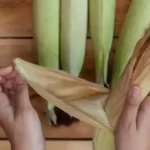If you’ve just finished prepping potatoes and you’re staring at a pile of spent peels, you might be considering whether you can turn them into something beneficial for your garden instead of tossing them in the trash. If you’re committed to reducing waste, discovering how to compost potato peels is a viable, sustainable, and responsible option. Hooray!
Potato peels are rich in nutrients like phosphorus, nitrogen, magnesium, and potassium. The finished compost contains organic matter that helps improve soil structure, making it looser and better at retaining moisture. To prevent fungal growth in your pile or bin, avoid composting potato peels with signs of potato blight (yellow patches with brown centers on leaves and dark patches on tubers).
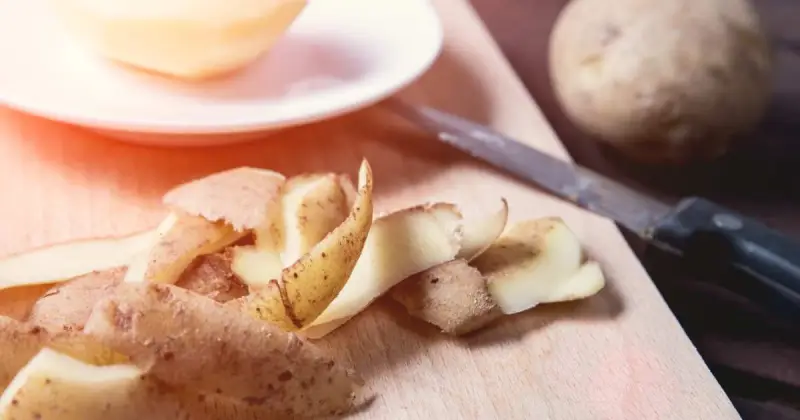
In this article, I’ll explain how to add potato peels to your compost heap safely, along with some insider tips on how you would be able to recognize infected peelings with a fungal disease called potato blight.
Additionally, I will provide specific steps to compost your potato peels effectively and keep your compost perfectly safe for your vegetables and other crops. This way, you get to engage in a sustainable garden practice with the help of your potato crops.
Humble Highlights
- Discover how composting the humble potato peel enriches the soil, releases essential nutrients like phosphorus and magnesium, improves soil structure, and promotes the growth of beneficial microorganisms so you can enhance your garden throughout the year!
- Save time by knowing how to speed up your backyard composting process with this quick but efficient tip for potato peels that only takes a few seconds AND increases microbial activity within your pile so your compost can perform year-round.
- Discover why potato blight is so prevalent among crops and the two primary signs you must watch out for as a home grower to ensure it doesn’t end up in your compost and contaminate your garden.
Benefits Of Composting Potato Peelings
Adding potato peels to your compost bin effectively enriches the soil and supports plant health. The benefits of composting extend to the potent macro-nutrients that decomposed potato peelings release. Specifically, peels contain nutrients like nitrogen, a critical component that contributes to the synthesis of plant proteins. Other nutrients include fibers, vitamins (C, B6, B3), minerals (potassium, magnesium, iron), and phytochemicals like carotenoids and flavonoids.
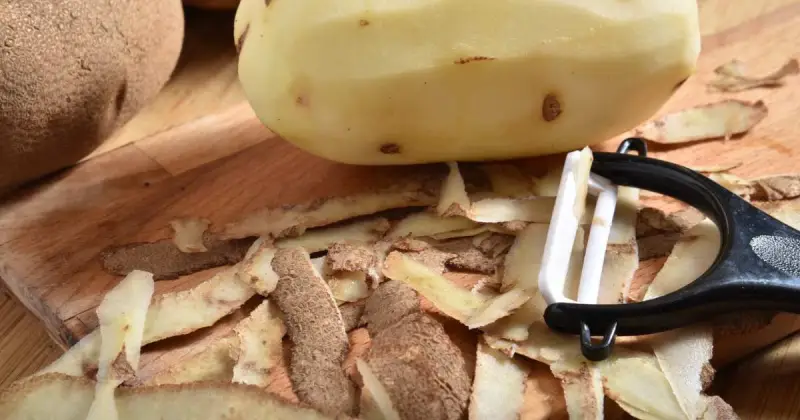
Integrating potato peels into your compost adds a valuable source of organic matter that improves soil structure and water retention. Moreover, including these peels promotes the growth of beneficial microorganisms (mycorrhizal fungi, nitrogen-fixing bacteria, earthworms), essential for a healthy ecosystem. 1
How Long Does It Take For Potato Peels To Decompose In Compost
The time it takes for potato peels to decompose can vary depending on several factors, including environmental conditions, the size and thickness of the peels, and the composition of your compost pile.
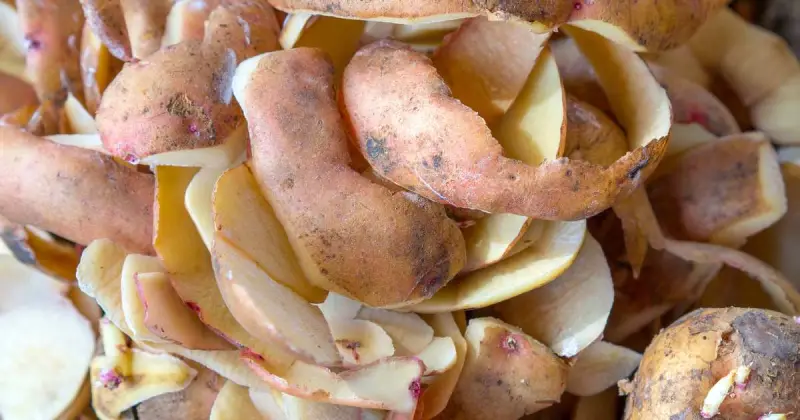
Their decomposition timeline can vary, ranging from 3 to 6 months, influenced by the peels’ initial condition and environmental factors. Typically, it takes about 10-12 weeks for them to transform into high-quality compost suitable for your garden. 2
The following are some of the environmental factors to consider:
- Temperature: Warmer climates accelerate decomposition, while colder climates slow.
- Moisture: Adequate moisture is vital for a successful compost pile, while dryness hinders production.
- Oxygen Levels: Proper aeration aids decomposition, while anaerobic conditions (without air) slow production and may cause unpleasant odors, attracting pests and rodents.
- Microbial Activity: Active microbes (bacteria, including mesophilic bacteria and thermophilic bacteria, fungi, such as molds and yeast, and protozoa) quicken the process.
- Pile Size: Larger piles generate more heat and spur faster decomposition, while smaller ones may be slower to produce mature humus (compost).
To facilitate efficient breakdown of your potato peel compost, make it a routine to turn the compost regularly, ideally once weekly. This process, which takes just a few minutes, helps ensure proper aeration and consistent moisture levels, crucial for effective decomposition and timely composting.
Preparing For The Composting Process
Before tossing your potato peels into the compost heap, chop them into smaller pieces to speed up decomposition. Shredding the peels increases the surface area available for microbial activity, a critical factor in composting.

Increasing surface area means a larger surface area provides more contact points for beneficial microorganisms to access and break down the organic material. The bottom line is that it promotes increased microbial contact, efficient enzyme action, shorter diffusion pathways, optimal microbial colonization, and, ultimately, faster decomposition rates.
When preparing potato peelings for addition to your compost, consider the safety implications of potential blight spread. Blight is a destructive plant disease caused by fungal or bacterial pathogens, leading to rapid wilting, browning, and death of plant parts like leaves, stems, or fruit, and it can severely harm crops and garden plants. And because store-bought potatoes may harbor blight fungus. It is crucial to exclude any peels from visibly infected potatoes. 3
Tossing potato peels in your backyard compost is super easy, adds valuable nutritional content, and helps the environment by reducing household waste that would otherwise be transported to the landfill. Check out this short but informative video below that details how simple it is to compost the humble potato peel, along with some additional information you can use today!
Steps To Compost Potato Skins
- Chop or shred the peels for faster decomposition.
- Because potato peels are considered green (nitrogen), you’ll want to mix them thoroughly with brown materials (leaves, straw, shredded newspaper) to balance compost effectively.
- Layer or mix potato peels throughout your pile for better aeration.
- Maintain proper moisture. Soggy conditions are not welcome as they can stop decomposition altogether. Regularly inspect, maintain, and turn your pile for adequate aeration.
- Cover the compost with a lid or alternative covering for moisture control and pest deterrence.
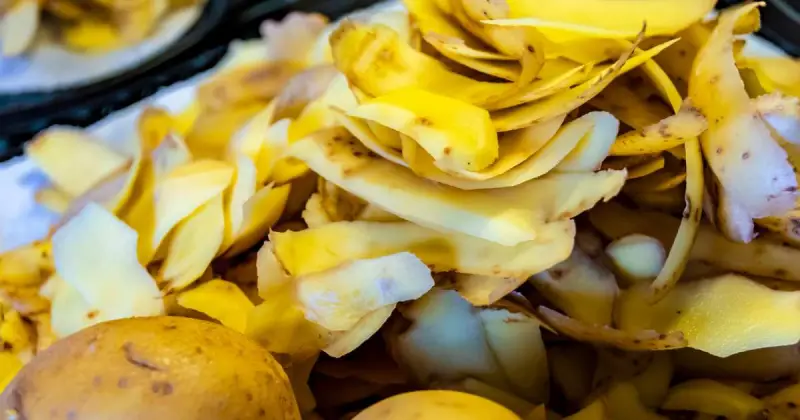
Can You Put Cooked Potato Peels In The Compost Pile
Cooked potato peels are considered green or nitrogen-rich and can break down in your compost pile. However, there are a few things to keep in mind:
| Pros | Cons |
|---|---|
| Nutrient enrichment for plant growth | Slower decomposition due to cooking |
| Reduces kitchen waste and promotes eco-friendly practices | Releases bad odor if not managed properly |
| Great addition to organic mix which helps improve soil structure | Attracts pests like rodents or insects |
| Enhanced microbial activity that aids the decomposition process | May contribute to a balancing challenge for proper composting ratios |
Presence Of Potato Blight: Not Good For The Compost
Potato blight is a persistent fungal disease that can damage your crops. This kind of disease is usually found in tomato and potato plants. So, before you compost tomato and potato skins, you must check first for any signs of blight.
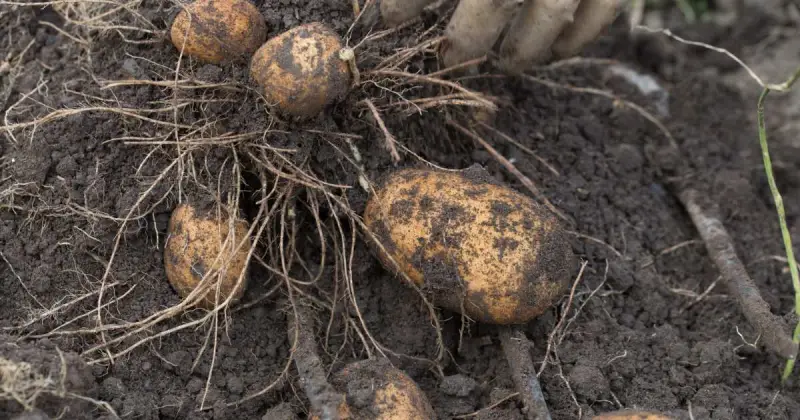
When considering the composting of potato skins along with other organic materials like chemical-free grass clippings and kitchen scraps, it’s essential to ensure there are no indications of blight infection. Its spores can persist from one season to the next by surviving on live plant tissue, and infected potato tubers are ideal hosts for these spores. Therefore, it’s essential to be diligent and observe any signs of trouble in your garden. 5
Do not add potatoes infected with blight on your compost heap to mitigate the risk. Some of the signs of its presence include the following:
- Yellow patches with brown centers on the leaves
- Dark, sunken patches on potato tubers
Potatoes displaying these symptoms should be discarded rather than included in your compost. However, some experts opt to deeply bury these infected peels within the compost pile and integrate the resulting compost into the soil to dilute any residual spores and reduce the likelihood of transmission. The choice is yours, but I would rather discard affected potatoes rather than risk infection throughout my garden.
Tips In Composting Potato Peels (Sweet Potatoes & White Potatoes)
While potato peels can be composted in your compost bin, there are complications that you might want to consider before adding them to your pile, such as odors or pests and the presence of potato blight, as mentioned above, which is common in potato and tomato plants.
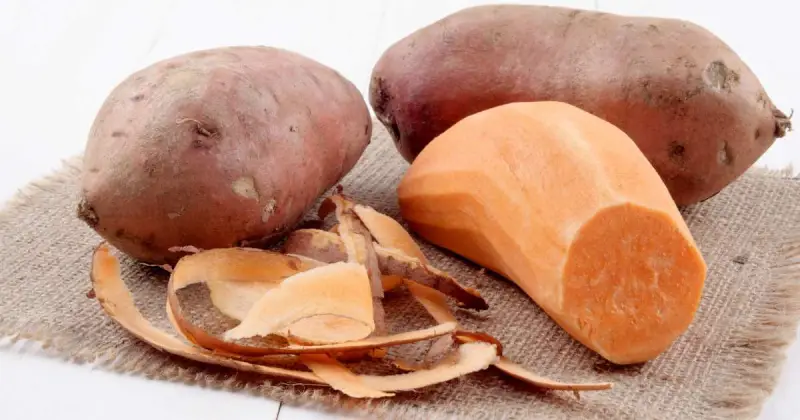
Below are some basic tips to consider:
- Cut the peels into smaller pieces before adding them. Introduce potato peels in moderation to maintain a balanced compost mix.
- Bury peels deep into the pile to deter pests and reduce the risk of sprouting. 6
- Regularly turn your compost pile to aerate and speed up decomposition. This method of turning your pile is called hot composting and is a popular and effective method for many backyard gardeners as it produces compost quickly.
- Maintain moisture levels, but avoid water-logging to prevent anaerobic (without air) conditions that can cause odors and a stagnant pile.

Conclusion
Incorporating potato peels into your compost is an intelligent and cost-effective addition to your organic mix, as they enrich your garden’s soil with nutrients. You must prepare these scraps properly, be informed about potential risks, and maintain a healthy pile or heap.
While potato peels contain nitrogen, essential to your organic mix, whole potatoes, and their skins can spread a disease called potato blight. Other issues include sprouting, pest attraction (usually rodents and insects), imbalance in organic materials, and unpleasant odors.
And remember, as you tackle all these issues, you’re not just disposing of your leftover peels, you’re also actively participating in your garden’s lifecycle.
Are you eco-friendly by composting potato peels in your backyard pile? Drop us a line below in the comments because we’d love to know what other materials you toss in your compost heap to keep household waste to a minimum!
SOURCES
- ResearchGate – Use Of Potato Peelings In Composting Technique
- Colorado State University, Master Gardener Extension – Making Compost
- University Of Minnesota, Extension – Composting In Home Gardens
- North Carolina State University, Extension – Backyard Composting Of Yard, Garden, And Food Discards
- Wikipedia – Phytophthora infestans
- Forest Society – The Promise Of Potato Peels




